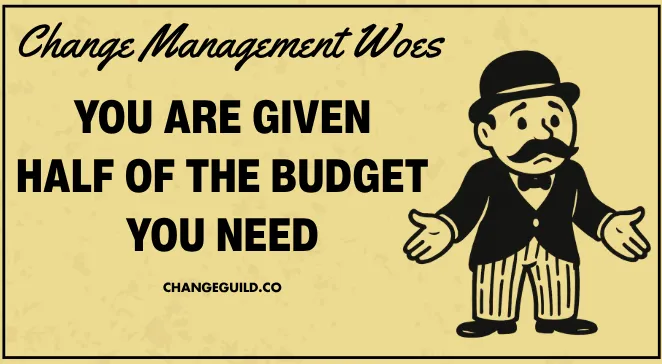It’s a familiar story. The project is already in full swing, timelines are locked, and someone suddenly remembers, “We need change management.” But by the time you’re brought in, the budget has already been squeezed dry. When funding is tight, you don’t have the luxury of a full suite of change management tools - but you do have options. This guide will show you how to prioritize essential change management activities that deliver the most value, even on a shoestring budget.
Why Change Management is Often Underfunded
- Reactive Planning: CM is seen as an afterthought rather than a strategic necessity.
- Competing Priorities: Project leaders focus on technical deliverables, leaving little budget for CM.
- Misunderstanding CM Value: Leaders may see CM as “soft skills” rather than a driver of success.
Change Management Triage: What to Prioritize First
When funding is limited, focus on the essentials:
1. Stakeholder Identification and Mapping
- Understand who is impacted and who has influence over the change.
- Prioritize high-impact stakeholders who can drive adoption or derail the project.
2. Communication Planning
- Focus on clear, consistent messaging. Even if you can’t afford a full communication campaign, prioritize key messages.
- Use low-cost channels like email, town halls, or team meetings.
3. Leadership Alignment
- Coach leaders to become visible and active sponsors of the change.
- Use a one-page E/M/R guide (Express, Model, Reinforce) to help them support the change effectively.
4. Training and Coaching
- Prioritize just-in-time training, focusing on essential skills and knowledge.
- Use existing materials, internal subject matter experts, or micro-learning sessions to save costs.
5. Feedback Mechanisms
- Use simple, low-cost methods to gather feedback (pulse surveys, quick focus groups, or even a shared inbox for comments).
High-Impact, Low-Cost CM Tactics
- Leverage Existing Channels: Use existing meetings (town halls, team huddles) to share key messages.
- Create a Quick-Start Guide: A simple PDF that outlines the key changes, how they impact users, and where to get help.
- Peer Coaching: Identify a few change champions who can answer questions and provide support.
- Micro-Learning Videos: Use short, low-budget videos (even recorded on a smartphone) to demonstrate key concepts.
- Use Templates: Reuse existing communication templates, stakeholder maps, and feedback forms.
- Social Proof: Share quick success stories from early adopters.
How to Secure the Most Impact with Limited Funding
- Negotiate for Non-Financial Support: Can you get access to communication channels, meeting time, or internal trainers?
- Frame CM as Risk Management: Make it clear that poor adoption will cost more than the CM investment.
- Leverage Existing Resources: Are there existing materials you can repurpose? Can you partner with HR or internal communications?
Realistic Budgeting: What Can You Do with $0, $500, or $5,000?
| Budget | CM Activities |
|---|---|
| $0 | Emails, team meetings, peer coaching, leader messages. |
| $500 | Create a simple training video, print job aids, conduct a pulse survey. |
| $5,000 | Design a micro-learning series, host a change workshop, provide leader coaching. |
Advanced Tips for High-Impact CM on a Budget
- Track and Report Results: Even small wins are worth celebrating. Track engagement, adoption, and feedback.
- Use Data for Leverage: If you demonstrate impact with minimal funding, you have a case for more investment in future projects.
- Be Honest About Trade-Offs: Make it clear to leadership what will not be achieved without funding.
Final Thought: Value Over Volume
Effective change management is not about doing everything - it’s about doing the right things. When funding is tight, your ability to prioritize, focus, and creatively leverage existing resources will make all the difference.
Power to the Practitioner.
Tight budgets don’t mean low impact
ChangeGuild helps change practitioners design smart, focused strategies that deliver results—even when resources are limited. From high-impact, low-cost tactics to creative stakeholder engagement, we’ll help you make every dollar and hour count.
Book a discovery call to rethink what’s possible when funding is tight.








